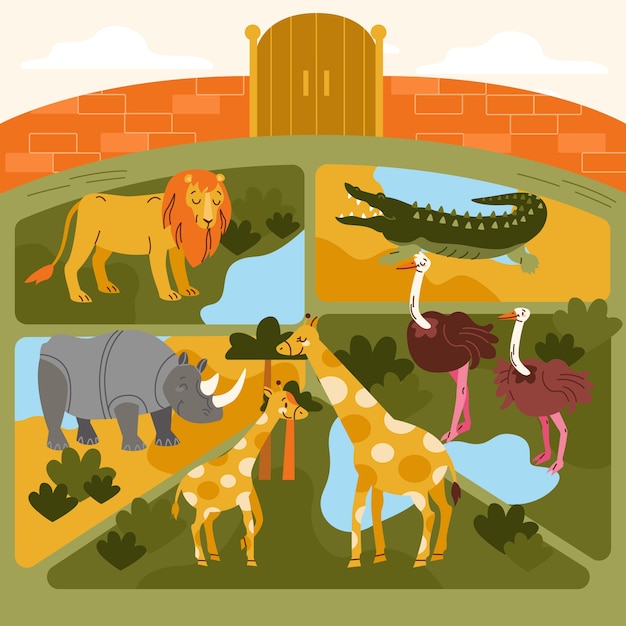Amazing Facts About the Animal Kingdom

The blue whale is not only the largest animal in the animal kingdom, but also the largest creature to have ever lived on Earth.
The regal lion is known as the king of the jungle, but it actually inhabits grasslands and savannas.
The honeybee’s remarkable navigation skills allow it to communicate the exact location of nectar sources to its hive mates.
The chameleon’s ability to change its skin color helps it blend in with its surroundings and stay camouflaged from predators.
The Arctic fox has a unique adaptation that allows it to change the color of its fur from dark brown in summer to white in winter.
The kangaroo’s muscular tail acts as a powerful third leg, providing balance and propelling it forward during leaps.
The tiny hummingbird’s wings flap incredibly fast, allowing it to hover mid-air and even fly backward.
Many species of octopus have the incredible ability to change both the color and texture of their skin to match their surroundings.
The platypus is one of the few mammals that lay eggs, possess venomous spurs, and have a duck-like bill.
The narwhal, often referred to as the unicorn of the sea, possesses a long, spiraled tusk that is actually a modified canine tooth.
The cheetah is the fastest land animal, capable of reaching speeds up to 70 miles per hour (112 kilometers per hour) in short bursts.
The anteater has a specialized tongue that can extend up to two feet long, allowing it to reach deep into ant and termite mounds.
Amazing Facts About the Animal Kingdom part 2
The gurnard fish has legs made of modified pectoral fins, which it uses to walk along the ocean floor.
The albatross has the longest wingspan of any bird, allowing it to glide effortlessly for hours without flapping its wings.
The giraffe has an incredibly long neck, which is actually made up of only seven vertebrae, just like humans.
The red-eyed tree frog has distinctive bright red eyes that assist in terrifying predators and finding mates in the dark.
The poison dart frog’s vibrant colors serve as a warning signal to potential predators, indicating its toxic nature.
The electric eel has special organs that can generate electric shocks of up to 600 volts to stun or kill prey.
The humpback whale is known for its complex and haunting underwater songs, which can be heard over long distances.
The firefly’s bioluminescence is a result of a chemical reaction that occurs in its abdomen, allowing it to emit light for communication and attracting mates.
The bumblebee’s body is covered in tiny hairs that collect pollen as they move from flower to flower, making them important pollinators.
The star-nosed mole has a unique snout covered in 22 fleshy tentacles that help it sense its environment and locate prey.
The African elephant is the largest land animal, with some males weighing up to 14,000 pounds (6,350 kilograms).
The hermit crab uses discarded seashells as mobile homes, moving into larger shells as it grows.
The kiwi, a flightless bird native to New Zealand, lays the largest eggs in proportion to its body size of any bird.
The cuttlefish has the ability to change the pattern and color of its skin in a matter of seconds, making it a master of disguise.
The pangolin is the only mammal with scales, which protect it from predators and make it one of the most trafficked animals in the world.
The praying mantis has specialized front legs that it uses to catch and grip prey before devouring it.
The hammerhead shark’s unique head shape provides it with improved vision and enhanced maneuverability.
The bald eagle, a symbol of strength and freedom, has a wingspan of up to seven feet (2.1 meters).
The beaver constructs elaborate dams and lodges using tree branches, mud, and rocks to create a safe habitat.
The great white shark is widely regarded as one of the most formidable predators in the ocean, with powerful jaws and rows of serrated teeth.
The ostrich is the largest and fastest-running bird, capable of reaching speeds up to 60 miles per hour (97 kilometers per hour).
The peacock’s extravagant display of vibrant feathers is actually the male’s way of attracting a mate.
The Portuguese man o’ war, despite its resemblance to a jellyfish, is actually a colony of individual organisms working together.
The snow leopard’s thick fur and large paws act as natural snowshoes, helping it navigate through deep snow in its mountainous habitat.
The red kangaroo is the largest kangaroo species, capable of hopping up to 40 miles per hour (64 kilometers per hour).
The orca, also known as the killer whale, is actually a type of dolphin and the largest member of the dolphin family.
The axolotl, also known as the Mexican walking fish, has the remarkable ability to regenerate lost body parts, including limbs and organs.
The Emperor penguin, known for its resilience in the harsh Antarctic climate, takes turns incubating their eggs on their feet to keep them warm.
The electric ray has specialized electric organs on its underside, allowing it to generate electric shocks to stun prey and deter predators.
The basking shark, despite its huge size, feeds primarily on tiny plankton by filtering it through its gill rakers.
The praying mantis exhibits sexual cannibalism, with females often devouring their mates after or during mating.
The axolotl remains in its larval form throughout its life, never undergoing metamorphosis into the adult stage.
The Venus flytrap, a carnivorous plant, catches and digests insects using specialized leaves that snap shut when triggered by touch.

